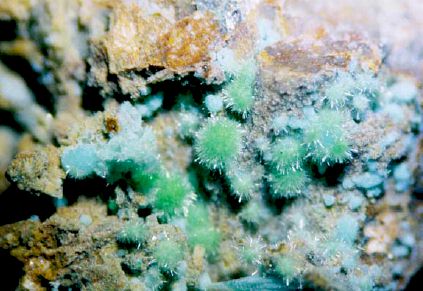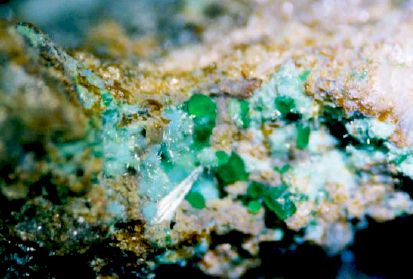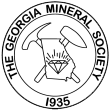"Those magnificent Copper Arsenates:"
by
Dave Babulski, Ed.D.
("Tips and Trips", Vol. XXXIV/seven, July 2005, page 5.)
The element arsenic (As) is located on the Periodic Table of elements in the same semi-metal band as the elements boron, silicon and tellurium. As such, the element arsenic exhibits similar characteristics to the other semi-metals. Silicon for example, when combined with the element oxygen forms the silicate (SiO2) radical. This unique combination of the elements silicon and oxygen bonds with a bewildering array of other elements to form the large number of silicate minerals. Likewise when the element arsenic is combined with oxygen, it forms the arsenate (AsO4) radical. Like the silicate radical, this unique combination of the elements arsenic and oxygen bonds with a large number of other elements (mostly metallic in nature) to form the large number of arsenate mineral species.
Interestingly enough, the metallic element copper (Cu) bonds readily with the arsenate combination and forms the bulk of the arsenate mineral species. For the micromounter this is a fortuitous situation as there are a number of well-known primary copper mineral deposits where arsenic bearing hydrothermal fluids have reacted with the primary copper minerals under oxidizing conditions forming the secondary copper arsenate minerals. Most of these unique mineral species only crystallize in micro form. One of more well known of these mineral occurrences is the Tintic Mining District in Utah and the Antelope Mining District in Nevada. When more than one of the copper arsenates are present in one specimen, the color and variety of crystal form is just awesome. In the Gold Hill Mine in Tooele County, Utah, the copper arsenates conichacite, strashimirite and mixite occur together in one specimen.
The photographs at right show these three minerals in one specimen. A careful analysis of this specimen shows that all three of these copper arsenate minerals did not crystallize at the same time, but most likely represent subtle changes in the chemistry of the hydrothermal mineralizing fluids. Strashimitite, which is a copper arsenate hydroxide penta-hydrate, appears to have been deposited first, followed by conichalcite and then mixite. Chemically speaking, conichalcite is a calcium copper arsenate hydroxide and mixite is a bismuth copper arsenate hydroxide tri-hydrate. The mineralizing fluids appear to have become enriched in calcium and bismuth as the minerals were being deposited. What is really cool about these specimens is the conichalcite. This mineral occurs as bright green spherules. A very close examination under the microscope of these spherules shows them to be hollow spheres of conichalcite. It is unknown at this point if the hollow spheres are actually filled with fluid. It is also interesting to speculate on how these hollow spherules formed.

In this image, ball like sprays of green acicular strashimirite and light blue mixite populate the matrix.

In this image, conichalcte, strashimirite and mixite are all present on the matrix.
(Both photographs above are courtesy of Dave Babulski from his collection. They were photographed with Kodak ASA 400 film at a magnification of 25X. The light source was a white light LED.)
So for some real interesting micromounting adventures you can't beat those magnificent copper arsenates. Most of the mineral dealers carry copper arsenates from a variety of localities. Those from the Tintic Mining District in Tooele County, Utah are among the finest. Until next time, may all your skies be blue and all your vugs be crystal filled.
Interestingly enough, the metallic element copper (Cu) bonds readily with the arsenate combination and forms the bulk of the arsenate mineral species. For the micromounter this is a fortuitous situation as there are a number of well-known primary copper mineral deposits where arsenic bearing hydrothermal fluids have reacted with the primary copper minerals under oxidizing conditions forming the secondary copper arsenate minerals. Most of these unique mineral species only crystallize in micro form. One of more well known of these mineral occurrences is the Tintic Mining District in Utah and the Antelope Mining District in Nevada. When more than one of the copper arsenates are present in one specimen, the color and variety of crystal form is just awesome. In the Gold Hill Mine in Tooele County, Utah, the copper arsenates conichacite, strashimirite and mixite occur together in one specimen.
The photographs at right show these three minerals in one specimen. A careful analysis of this specimen shows that all three of these copper arsenate minerals did not crystallize at the same time, but most likely represent subtle changes in the chemistry of the hydrothermal mineralizing fluids. Strashimitite, which is a copper arsenate hydroxide penta-hydrate, appears to have been deposited first, followed by conichalcite and then mixite. Chemically speaking, conichalcite is a calcium copper arsenate hydroxide and mixite is a bismuth copper arsenate hydroxide tri-hydrate. The mineralizing fluids appear to have become enriched in calcium and bismuth as the minerals were being deposited. What is really cool about these specimens is the conichalcite. This mineral occurs as bright green spherules. A very close examination under the microscope of these spherules shows them to be hollow spheres of conichalcite. It is unknown at this point if the hollow spheres are actually filled with fluid. It is also interesting to speculate on how these hollow spherules formed.

In this image, ball like sprays of green acicular strashimirite and light blue mixite populate the matrix.

In this image, conichalcte, strashimirite and mixite are all present on the matrix.
(Both photographs above are courtesy of Dave Babulski from his collection. They were photographed with Kodak ASA 400 film at a magnification of 25X. The light source was a white light LED.)
So for some real interesting micromounting adventures you can't beat those magnificent copper arsenates. Most of the mineral dealers carry copper arsenates from a variety of localities. Those from the Tintic Mining District in Tooele County, Utah are among the finest. Until next time, may all your skies be blue and all your vugs be crystal filled.

Copyright © Georgia Mineral Society, Inc.
